Handbag

A handbag, also purse or pouch in North American English, is a handled medium-to-large bag that is often fashionably designed, often used by women, to hold personal items.
"Purse" or "handbag" or "pouch"
The term "purse" originally referred to a small bag for holding coins. In British English, it is still used to refer to a small coin bag. A "handbag" is a larger accessory that holds objects beyond currency, such as personal items. American English typically uses the terms purse and handbag interchangeably. The term handbag began appearing in the early 1900s. Initially, it was most often used to refer to men's hand-luggage. Women's bags grew larger and more complex during this period, and the term was attached to the accessory.[1] Handbags are valued for their stylishness as visual accessories as well as for their function.[2]
The verb "to handbag"[3] derives from UK prime minister Margaret Thatcher's habit of pulling scraps of paper out of her handbag in meetings and reading aloud the comments she had written on them.[4] The verb's more general meaning of "treating ruthlessly" came to symbolise Thatcher's whole style of government. Julian Critchley, one of her biggest Tory backbench critics, once said, "Margaret Thatcher and her handbag is the same as Winston Churchill and his cigar." [5]
Modern origin

Early modern Europeans wore purses for one sole purpose: to carry coins. Purses were made of soft fabric or leather and were worn by men as often as ladies; the Scottish sporran is a survival of this custom. In the 17th century, young girls were taught embroidery as a necessary skill for marriage; this also helped them make very beautiful handbags.[7] By the late 18th century, fashions in Europe were moving towards a slender shape for these accessories, inspired by the silhouettes of Ancient Greece and Rome. Women wanted purses that would not be bulky or untidy in appearance, so reticules were designed. Reticules were made of fine fabrics like silk and velvet, carried with wrist straps. First becoming popular in France, they crossed over into Britain, where they became known as "indispensables."[8] Men, however, did not adopt the trend. They used purses and pockets, which became popular in men's trousers.[9]
The modern purse, clutch, pouch or handbag came about in England during the Industrial Revolution, in part due to the increase in travel by railway. In 1841 the Doncaster industrialist and confectionery entrepreneur Samuel Parkinson (of butterscotch fame) ordered a set of travelling cases and trunks and insisted on a travelling case or bag for his wife's particulars after noticing that her purse was too small and made from material that would not withstand the journey. He stipulated that he wanted various handbags for his wife, varying in size for different occasions and asked that they be made from the same leather that was being used for his cases and trunks to distinguish them from the then-familiar carpetbag and other travelers' cloth bags used by members of the popular classes. H. J. Cave (London) obliged and produced the first modern set of luxury handbags, as we would recognize them today, including a clutch and a tote (named as 'ladies travelling case'). These are now on display in the Museum of Bags and Purses in Amsterdam. H. J. Cave did continue to sell and advertise the handbags, but many critics said that women did not need them and that bags of such size and heavy material would 'break the backs of ladies.' H. J. Cave ceased to promote the bags after 1865, concentrating on trunks instead, although they continued to make the odd handbag for royalty, celebrities or to celebrate special occasions, the Queen's 2012 Diamond Jubilee being the most recent. However, H.J. Cave resumed handbag production in 2010.[10]
20th century
During the 1940s, the rationing of textiles for World War II led to the manufacturing of handbags made in materials like raffia[11] or crocheted from yarn. Some women crocheted their own small handbags from commercial patterns during this period.
Men's bags

The oldest known purse dates back more than 5000 years, and was a pouch worn by a man, Ötzi the Iceman.[12] Men once carried coin purses. In early Modern Europe, when women's fashions moved in the direction of using small ornamental purses—which evolved into handbags—men's fashions were moving in another direction. Men's trousers replaced men's breeches during the course of the 18th and 19th centuries, and pockets were incorporated in the loose, heavy material. This enabled men to continue carrying coins, and then paper currency, in small leather wallets. Men's pockets were plentiful in 19th century and 20th century trousers and coats, to carry an ever-increasing number of possessions, such as pipes, matches, pocketknives, and so on, and they were an item frequently mended by their wives.[9] Women, on the other hand, have shown a strong demand for larger handbags that carry more items for everyday use.
Men's purses were revived by designers in the 1970s in Europe.[13] Since the 1990s, designers have marketed a more diverse range of accessory bags for men. The names man-purse and murse have been used. The designs are typically variations on backpacks or messenger bags, and have either a masculine or a more unisex appearance, although they are often more streamlined than a backpack and less bulky than a briefcase. These bags are often called messenger bags or organizer bags. The leather satchel is also common. Demand is strong after several years of popularity, possibly supported by the growing range of modern electronic devices men carry with them. Men's designer bags are produced by well-known companies such as Prada, Louis Vuitton, Coach, and Bottega Veneta in a variety of shapes and sizes. The global men's bag and small leather goods trade is a $4 billion a year industry.[14] Sales of men's accessories including "holdall" bags are increasing in North America.[15]
Types of handbags


As a fashion accessory, handbags can be categorized according to the silhouette of the bag, as well as the type of handle. The current popular handbag silhouettes are (as of 2011):
- Baguette: a small, narrow, rectangular shape purse, resembling a French loaf of bread (baguette)
- Barrel: shaped like a barrel or closed tube, usually with shoulder-length straps
- Bowling bag purse: a popular 1990s "retro" style for younger women, modelled after American bags used to carry bowling balls
- Bucket bag: shaped like a bucket, medium-size or large, with shoulder straps and a drawstring closure
- Clutch: a handbag without handles with detachable chain strap, rectangular in shape, often an evening bag but used during the day as well
- Doctor's bag: modelled after a Victorian era doctor's bag for making housecalls
- Drawstring: a purse that closes with a drawstring at the top, may have wrist- or shoulder-length straps, popular as an evening bag style
- Half-moon: shaped as a half-moon
- Hobo: medium-size crescent-shaped bag with a top zipper and often a slouch or dip in the centre; a modern, casual silhouette
- Kiondo: a handwoven handbag made from sisal with leather trimmings. It is indigenous to Kenya
- Lighted: a handbag with a lighting system which has been attempted since the 1950s without success until recently when in 2011 the first successful lighted handbag was brought to market.
- Messenger bag: one long strap worn across the body, inspired by bags worn by urban messengers to deliver business mail, a modern silhouette
- Minaudière: a small rectangular evening bag, usually hard-bodied, sometimes held inside a soft fabric bag that serves as a sleeve
- Muff: a winter bag made of real or faux fur, wool or velvet that has zippered compartments and a slip opening for hands
- Pocketbook: small purse, rectangular shape
- Pouch: small bag such as a pocket, teabag, money bag, sporran, etc.
- Saddle purse: shaped like a horse saddle, may have equestrian motifs and hardware to emphasize the design
- Satchel: a soft-sided case usually of leather
- Tote: medium to large bag with two straps and an open top
- Trapezoid: shaped as a trapezoid, usually made of stiff material
- Wristlet, a small handbag with a short carrying strap resembling a bracelet
Gallery of popular handbag silhouettes
 Bucket bag with drawstring closure.
Bucket bag with drawstring closure..jpg) Vintage clutch with fold-over closure, made of red snakeskin.
Vintage clutch with fold-over closure, made of red snakeskin. Hobo bag with top zipper, shoulder strap, and characteristic slouch in the middle.
Hobo bag with top zipper, shoulder strap, and characteristic slouch in the middle.- Collection of kiondo style handbags.
 Messenger bag from old truck tarp with seat belt as strap, made by Freitag, Switzerland (2008).
Messenger bag from old truck tarp with seat belt as strap, made by Freitag, Switzerland (2008).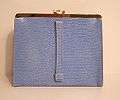 Vintage pocketbook.
Vintage pocketbook. Saddle shape, with equestrian hardware detail.
Saddle shape, with equestrian hardware detail.
- Hobo bag with unique variations, such as a bold abstract print and interesting hardware.
- Clutch made from eel skin, a strong but expensive alternative to cow, sheep, goat, or pig leather.
 Vintage evening bag, made of ivory satin encrusted with faux pearls and glass bugle beads.
Vintage evening bag, made of ivory satin encrusted with faux pearls and glass bugle beads.
According to type of handle, handbags are often categorized as:
- Tote: a medium to large bag with two straps and an open top
- Cross-body: one long strap that crosses over the body, with the bag resting at the front by the waist
- Sling bag: one long, wide strap that crosses over the body, with the bag resting on the back
- Shoulder bag: any bag with shoulder-length straps
- Clutch: handleless
Handbags that are designed for specific utilitarian needs include:
- Laptop purse: a medium to large bag that contains a padded interior compartment or sleeve for protecting a laptop computer
- Camera bag: for carrying photography equipment
- Gym bag: for carrying toiletry items and the clothing and/or shoes a person intends to use for their workout
- Cosmetic bag: a small bag for holding cosmetics, often made of synthetic waterproof protective material
- Duffle bag: a large cylindrical bag usually used for travel or sports gear, sometimes called a "weekend bag"
- Security bag: protects the carrier from travel theft and includes an invisible stainless steel strap sewn into the fabric and a protectant on the main zipper.
Hardware

A distinction can also be made between soft-body handbags or frame handbags, where a metal frame supports the textile or leather of the bag. Frame bags often use a kissing lock closure, with two interlocking metal beads set on the top of the frame. Kissing locks were popular on handbags during the early- to mid-20th century, and remain popular with vintage collectors and in "retro" designs. These locks are still seen on smaller change purses.
Diamanté clasps were in use by the 1930s.[11] In later decades, designers found popular success with zipper enclosures, flaps, and even magnetic clasps hidden in the fabric of handbags.
History worldwide
The need to organize one's belongings is universal, thus handbags exist in differing forms in cultures around the world. People have been quite clever in thinking of ways to use the materials at hand to create their bags; this section shows many different examples of handbags.
Gallery of traditional handbag types
 A bilum bag, used in Papua New Guinea. Bilums are made of "bush rope", cuscus fur or wool, and expand in size.
A bilum bag, used in Papua New Guinea. Bilums are made of "bush rope", cuscus fur or wool, and expand in size.
 Ojibwa bag with decorative beadwork; this particular bag was probably made for a child.
Ojibwa bag with decorative beadwork; this particular bag was probably made for a child.
 A Burmese Kachin bag or wallet. A Figure from the booklet Burmese Textiles, published in 1917 by Laura E. Start.
A Burmese Kachin bag or wallet. A Figure from the booklet Burmese Textiles, published in 1917 by Laura E. Start.- A Scandinavian Sámi purse (handbag) with shoulder strap.
- A Betel bag from West Timor, made around 1921. Called an aluk, such bags are still made.
 A modern handbag in a traditional Hakka Chinese-style floral fabric design.
A modern handbag in a traditional Hakka Chinese-style floral fabric design. North African bag with lizard head and paws.
North African bag with lizard head and paws.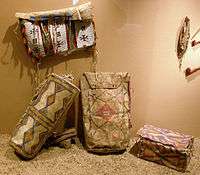 19th century bags and pouches of the Sioux.
19th century bags and pouches of the Sioux.- Bags exhibited in the Yunnan Nationalities Museum, Kunming, Yunnan, China.
Gallery of contemporary handbag types
 Ladies' Burberry handbag (2005).
Ladies' Burberry handbag (2005). Tanner Krolle Eva bag (2006).
Tanner Krolle Eva bag (2006).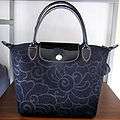 Longchamp tote bag (2010).
Longchamp tote bag (2010). Louis Vuitton bag (2010).
Louis Vuitton bag (2010). Ted Noten bag (2009).
Ted Noten bag (2009). Chanel 2.55 bag.
Chanel 2.55 bag.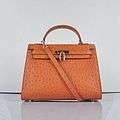
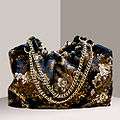 Adriana Allen handbag (2009)
Adriana Allen handbag (2009)- A handbag from French designer Etienne Aigner.
 Handbag shaped like vintage Volkswagen bus (2007).
Handbag shaped like vintage Volkswagen bus (2007).- A classic-looking bag made from black microfiber cloth.
- Crocheted bucket-style handbag by Sak.com.
- Handbags at the 2010 FONART exhibition in Mexico City.
 Bag made of recycled water sachets by Trashy Bags, Accra, Ghana (2012)
Bag made of recycled water sachets by Trashy Bags, Accra, Ghana (2012) Colorful handbag made from recycled materials (2012).
Colorful handbag made from recycled materials (2012). JulieApple's Yoga-a-GoGo bag made by AirDye technology that dyes fabric without the use of water.
JulieApple's Yoga-a-GoGo bag made by AirDye technology that dyes fabric without the use of water.
See also
References
- ↑ Browning, Marie (2006). Purse Pizzazz. Sterling Publishing. p. 8. ISBN 978-1-4027-4065-7.
- ↑ Miller, Seth. "Useful Information About Handbags".
- ↑ http://www.oxforddictionaries.com/definition/english/handbag
- ↑ "I was handbagged by Mrs Thatcher". Ollie Stone-Lee, BBC News. 9 April 2013. Retrieved 17 June 2014.
- ↑ http://www.telegraph.co.uk/news/politics/margaret-thatcher/8521433/Margaret-Thatcher-style-Aquascutum-and-the-original-power-dresser.html
- ↑ "Los Angeles County Museum of Art". Collectionsonline.lacma.org.
- ↑ Timmons, Henrietta. "History of Handbags- From the 14th Century to Today's Designer Bags".
- ↑ Hagerty, Barbara G. S. (2002). Handbags: a peek inside a woman's most trusted accessory. Running Press Book Publishers. pp. 14–5. ISBN 0-7624-1330-1.
- 1 2 Burman, Barbara and Carole Turbin, eds. (2003). Material Strategies: Dress and Gender in Historial Perspective. Wiley-Blackwell. pp. 83–4. ISBN 978-1-4051-0906-2.
- ↑ Stockley, Philippa (2 September 2012). "Yes, the contents mean a lot, but it's the bag that matters most". The Independent. Retrieved 27 September 2015.
- 1 2 Pederson, Stephanie (2006). Handbags: What Every Woman Should Know. David & Charles. p. 8. ISBN 9780715324950.
- ↑ Gerval, Olivier (2009). Studies in Fashion: Fashion Accessories. A & C Black. p. 44. ISBN 978-1-4081-1058-4.
- ↑ Sarti, Giorgio (2006). Vespa: 1946-2006: 60 Years of the Vespa. p. 117. ISBN 978-0-7603-2577-3.
- ↑ Standard & Poor's (2011). Standard & Poor's 500 Guide. "Coach Inc.": McGraw-Hill. ISBN 978-0-07-175491-0.
- ↑ Clifford, Stephanie (19 February 2012). "Men Step Out of the Recession, Bag on Hip, Bracelet on Wrist". The New York Times.
Further reading
- Pedersen, Stephanie (2006). Handbags: What Every Woman Should Know. Cincinnati: David & Charles. ISBN 9780715324950.